
50-60е
.pdf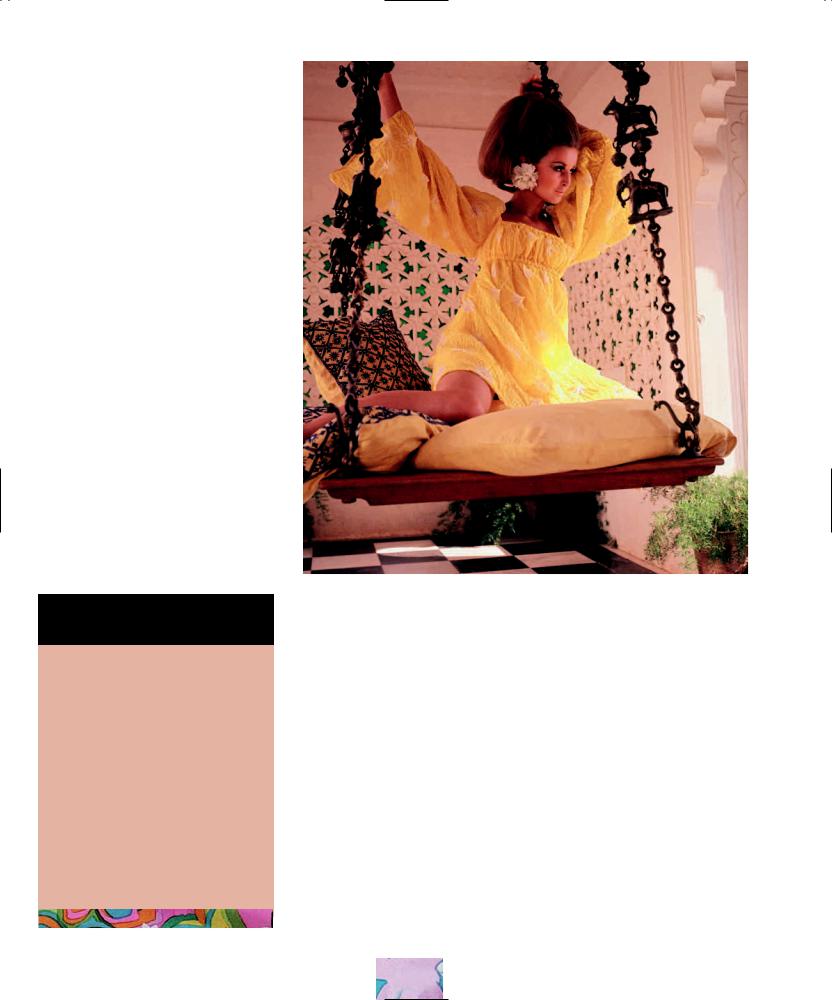
Right: In 1967, a Vogue model is
photographed wearing a floaty
“baby doll” dress in yellow Indian
cotton.
T H E B E A U T I F U L P E O P L E
“ The Beautiful People are nonviolent anarchists, constructive anarchists. They are the real breakthrough. But I have been worrying about the way they dress. It can’t be called a fashion because it’s old clothes.”
Fashion designer Mary Quant,
quoted in the Guardian
newspaper, 1967
B A B Y D O L L L O O K
A vogue for “baby doll” dresses played on the very youthful look that was fashionable. Girls wore short dresses, often with puffed sleeves and the skirt gathered into a high “empire” waistline just under the bust. Colors were pastel, patterns floral, and girls wore their hair long and loose.
T H E H I P P I E L O O K
The “summer of love” in 1967 was the height of the hippie movement in fashion, music, and lifestyle. Men and women wore their hair long and their clothes loose, ethnic, deliberately unstyled and anti-fashion. In a rebellion against the consumerism of the 1950s and 1960s, young people shunned anything produced or promoted by big business corporations and adopted a “natural” look. They opposed nuclear weapons, the war in Vietnam, and middle-class values and preached a doctrine of peace and love. Their clothes were made from natural fabrics, by traditional methods, and borrowed from ethnic styles around the world, including
20
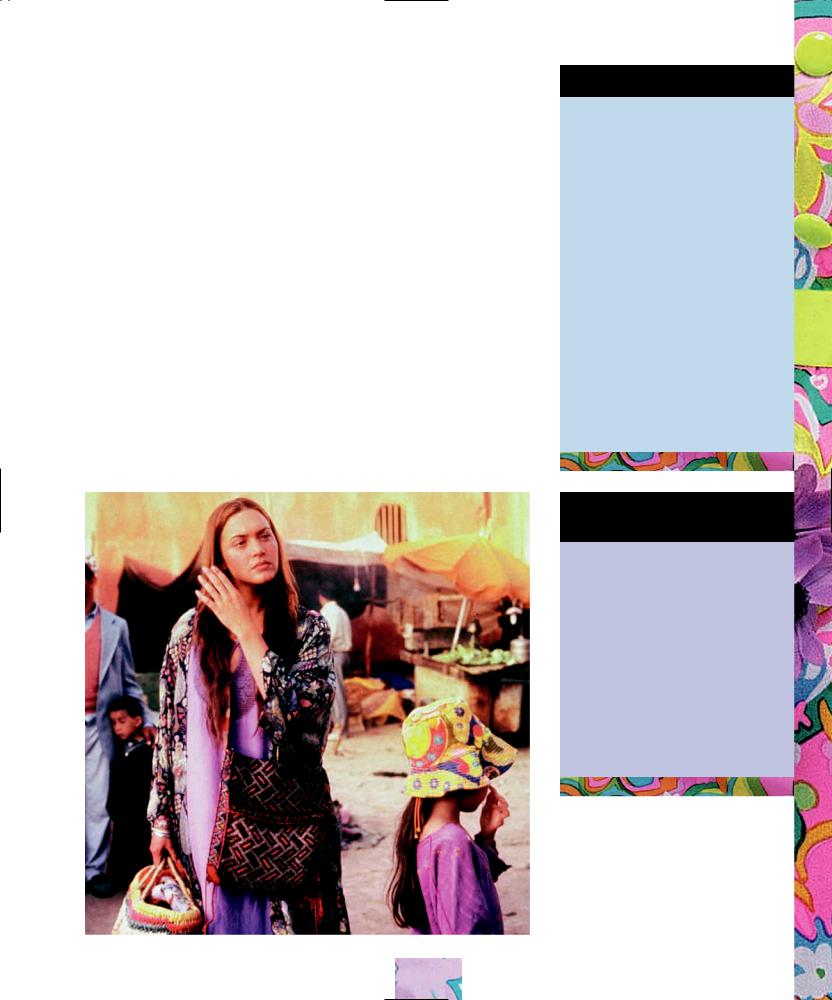
loose kaftans, Indian printed silks and cottons, and techniques such as tie-dye and batik. Fibers included cotton, hemp, wool (sometimes homespun), cheesecloth, and sheepskin.
Women wore wraparound skirts in coarse cotton, often block-printed with vegetable dyes in deep red, brown, ocher, and green. Skirts often reached the ankles. Above the skirt, a loose smock or shirt, frequently made of cheesecloth, was common. There might be a chunky sweater or long cardigan if it was cold, but shawls were widely used as well. Sweaters and shawls were often homemade, using traditional crafts such as knitting, crochet, and macramé. The look is easily re-created, since ethnic clothing of the same styles is still widely available.
R O M A N T I C S
Not only hippies turned to longer skirts. In the mainstream, too, disillusionment with the present led to a nostalgic look that borrowed from the early years of the century, with long “maxi” skirts, frilled blouses with high necks, and long velvet coats. These were often worn with lace-up ankle boots and floppy hats. Long, loose hair was given a pre-Raphaelite look by braiding it when wet.
PA N T Y H O S E
The large expanse of leg revealed beneath the miniskirt or hot pants was sheathed in a new invention— pantyhose. Before the 1960s, girls and women had worn stockings held up by garters. But one-piece pantyhose meant that short skirts no longer posed a problem to a girl’s modesty. These garments came in different colors and even with printed patterns or woven textures. Often, thick wool pantyhose were worn with boots that could come to anywhere between mid-calf and lower thigh.
M A K E I T — A T I E - D Y E D T O P
Wash a cotton T-shirt and tie the wet shirt in knots, or twist it and secure the folds with rubber bands. Mix a pack of dye according to the instructions. Soak the shirt in the dye for at least 20 minutes, then rinse it in cold water until the water runs clear. Undo the knots, rinse the shirt again, then allow it to dry.
Left: Actor Kate Winslet wears the
hippie look in the film Hideous
Kinky (1998), set in Morocco in
the 1960s.
21
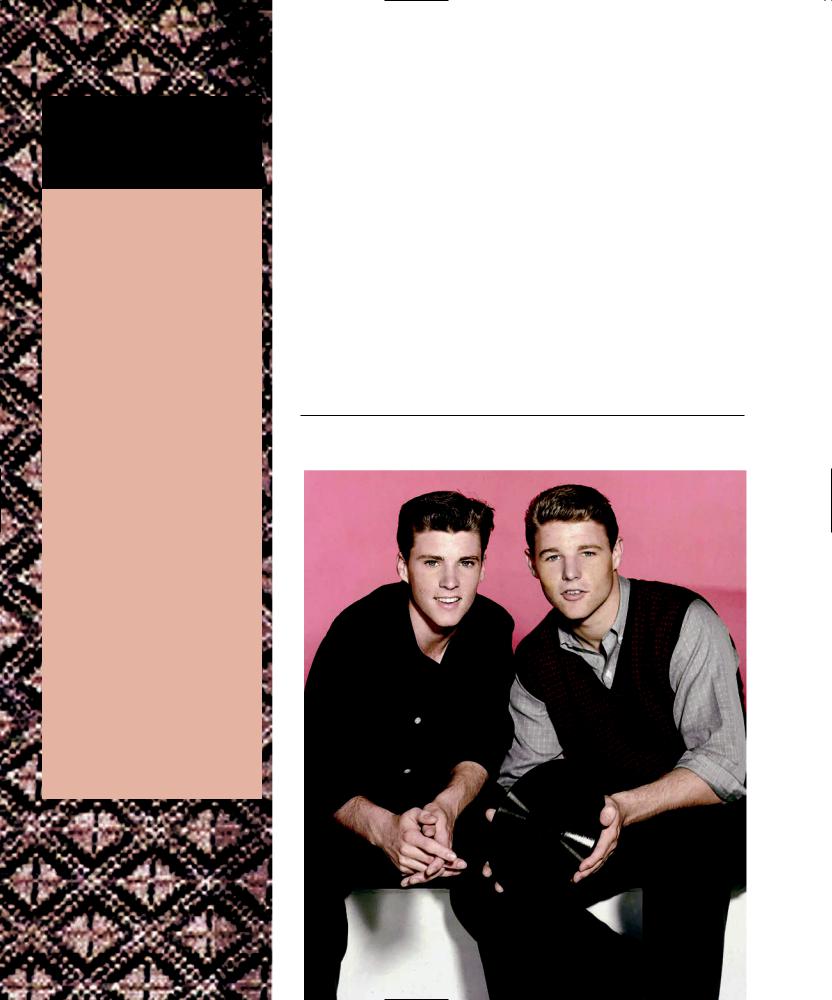
D R E S S I N G
J A M E S B O N D
T H E A M E R I C A N
WA Y
“The afternoon before he had had to submit to a certain degree of
Americanization at the hands of the FBI. A tailor had come and measured him for two singlebreasted suits in dark blue lightweight worsted (Bond had firmly refused anything more dashing) and a haberdasher had brought chilly white nylon shirts with long points to the collars. He had had to accept half a dozen unusually patterned foulard ties, dark socks with fancy clocks, two or three ‘display kerchiefs’ for his breast pocket, nylon vests and pants (called T-shirts and shorts),
a comfortable light-weight camelhair overcoat with over-buttressed shoulders, a plain grey snapbrim Fedora with a thin black ribbon and two pairs of hand-stitched and very comfortable black Moccasin ‘casuals.’”
Ian Fleming, Live and Let Die
(1954)
C H A P T E R 3
Men’s Day Wear
C I V I L I A N C L O T H I N G
At the end of World War II, men looked drab. Those who were demobilized (had left the armed forces) were issued a set of “civvies”— basic civilian clothing, which included a suit, shirt, shoes, socks, tie, raincoat, and hat. Men not in the armed forces often chose to give their clothing coupons to their wives rather than buy new clothes themselves.
Over the next 25 years, men’s costume would be transformed. During the 1950s, the popularity of casual wear such as jeans, slacks, and shorts increased along with the sharp formality of dudes on the one hand and neo-Edwardians on the other. Another transformation occurred during the 1960s, resulting in clothing that the demobilized men of 1945 would have considered unacceptably informal and effeminate.
Below: Teenage boys in the 1950s, as epitomized by the Nelson brothers,
wear casual slacks and knitwear.
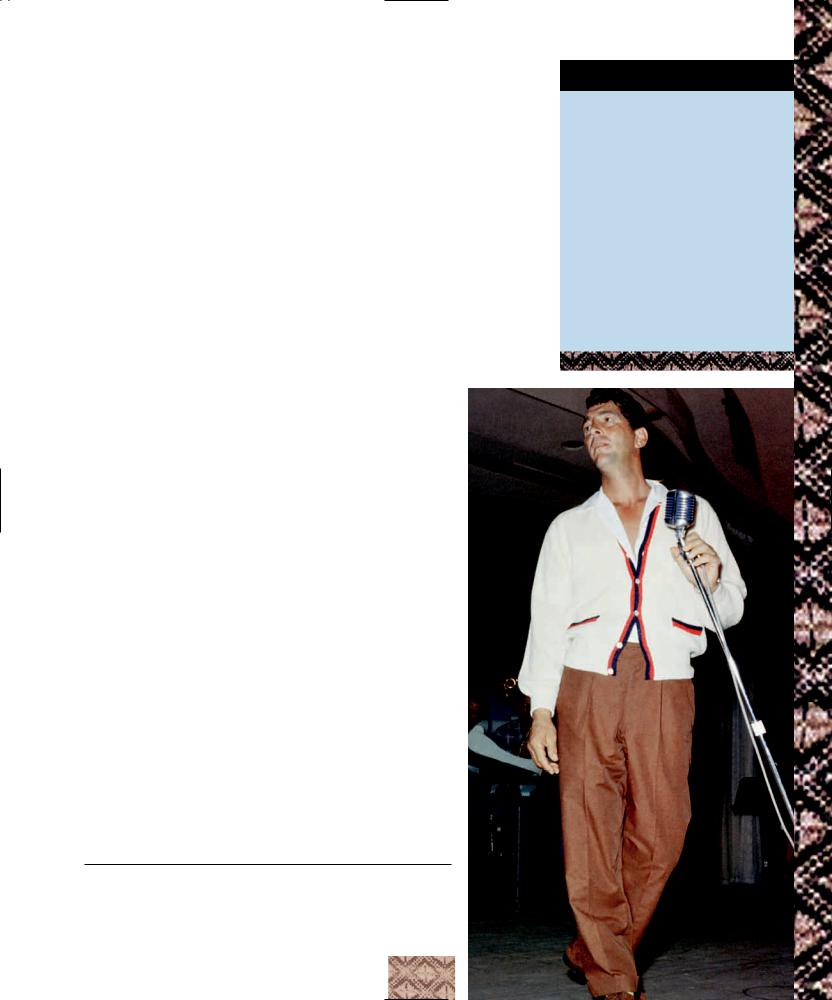
D A I L Y R O U T I N E
Most ordinary men in the 1950s wore unremarkable clothes. In the United States, conscription meant that many young men spent a lot of time in uniform. Out of uniform, they wore slacks and single-breasted blazers, usually with a plain white shirt and a narrow tie. The look was neat and groomed, almost a uniform in itself. Trousers had lots of fabric in the leg; they also had cuffs and were held up with suspenders. Many men wore a tie, even when not at work.
A casual look popularized by movie stars such as Rock Hudson, Steve McQueen, and Dean Martin combined loose, wool flannel pants, a patterned short-sleeved shirt or polo shirt, and loafers—low-heeled, slipon shoes. The shirt could be checked, striped, or more flamboyantly patterned. A cardigan, sweater, or sweater vest might be worn, too.
T H E R I S E O F T H E T E E N A G E R
The 1950s belonged to the newly emerging teenagers. Although the fashions of teenage rebels were worn by relatively few people at the time, they loom large in the collective memory of the 1950s. The intoxicating influence of music and movie stars such as Elvis Presley, James Dean, and Marlon Brando offered young men icons from whom they could copy an alternative look to that of the clean-cut “boy next door.”
In the early 1950s, stylish men around Mayfair in London adopted clothing reminiscent of Edwardian finery. Their single-breasted coats had velvet collars and were worn with narrow black trousers, horizontally striped shirts with stiff white collars, and bowler hats. Suit jackets had four buttons and were worn over a vest with small lapels. It was a tailored, expensive, and nostalgic look.
T E D D Y B O Y S
This neo-Edwardian look was soon transformed by the teddy boys, a youth culture that grew out of the streets of South London. Teddy boys turned the knee-length, singlebreasted coat into the “drape,” a fitted coat made of wool with velvet or satin detailing at the lapels and cuffs, and lots
Right: Photographed performing on stage in the mid-1960s, actor and “crooner” Dean Martin wears casual clothes, including a flat-collared shirt and cardigan.
FA I R I S L E
Knitted vests were frequently made following a traditional pattern called Fair Isle, which uses horizontal bands of small geometric shapes in different colors. It required only small quantities of wool in any single color. Fair Isle sweaters were often made using wool unraveled from old garments, including socks, and were a good way to recycle yarn at a time when people had little money.
23

Right: British teddy boys from the
1950s wear drapes with velvet
lapels and pocket flaps.
S H O E F E T I S H
“ You can burn my house, Steal my car,
Drink my liquor
From an old fruit jar.
Do anything that you want to do, but uh-uh,
Honey, lay off of my shoes
Don’t you step on my blue suede
shoes.
Well you can do anything but lay off of my blue suede shoes.”
Carl Perkins, Blue Suede
Shoes (sung by Elvis Presley,
1956)
of pockets. They paired it with narrow pants in the same or a different color and often with a brocade vest and stiff shirt. The shirt might be white or a dark, plain color and was worn with a narrow or shoelace “slim Jim” tie. Their shoes were suede with thick crepe soles. Their hair was long with a pompadour, held in place by Brylcreem and worn with long sideburns. The look was a strange blend of aggression, narcissism, and style.
Today, the drape can be created from a narrow knee-length coat by stitching velvet onto the lapels and cuffs. If there are not enough pockets, add velvet pocket flaps to simulate extra ones. Trousers should be a matching color—pale drainpipes can be dyed with fabric dye.
G R E A S E R S
The greaser look initially grew out of styles worn by working-class youths in the eastern states of the United States. They wore white or black T-shirts with the sleeves rolled up, or a white tank top, often with a dark-colored work
24
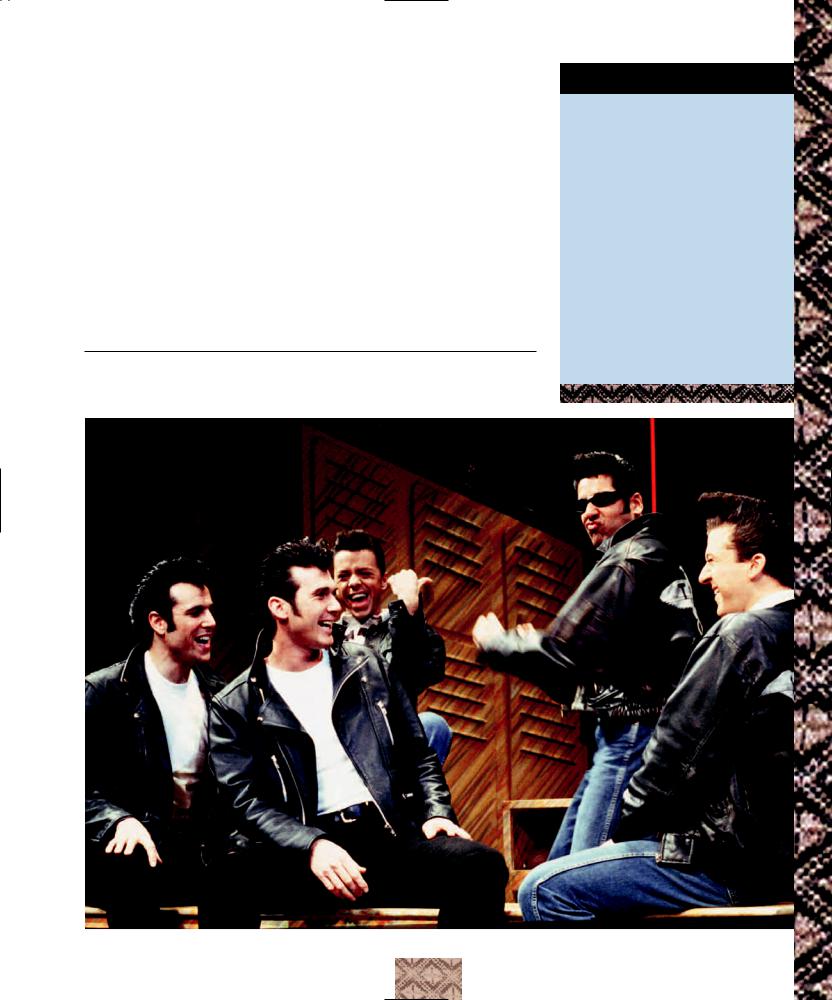
jacket or trench coat. Also popular were Sir Guy or Daddy-O shirts— these were short-sleeved shirts with a turned-back, flat collar, often in black with vertical panels of a contrasting color on either side of the front opening. A modern bowling shirt is a good substitute. Leather motorcycle jackets with the collar turned up or Levi’s denim jackets were popular alternatives to the work jacket.
Greasers wore jeans, preferably Levi’s 501 or 505, with the cuff turned back four inches (10 centimeters), or baggy cotton twill work pants, usually in sand, dark blue, or gray. Twill pants soon appeared in a wide range of colors, including orange and lime green. Footwear ranged from pointed Italian shoes through creepers and Converse All Star sneakers to motorcycle boots and army boots. A narrow-brimmed hat or flat cap was also popular.
Below: Leather jackets, white T-shirts, and tight jeans—a 1950s uniform
worn on stage in the musical Grease.
B L U E J E A N S
Jeans first became popular in the 1850s among mine workers in California. A century later, they became the uniform for a generation of young people. At first they were seen as nonconformist and aggressive—some social venues banned people wearing jeans—but that only added to their appeal. Jeans were favored by greasers but by the late 1950s and early 1960s were being worn by many people.
25
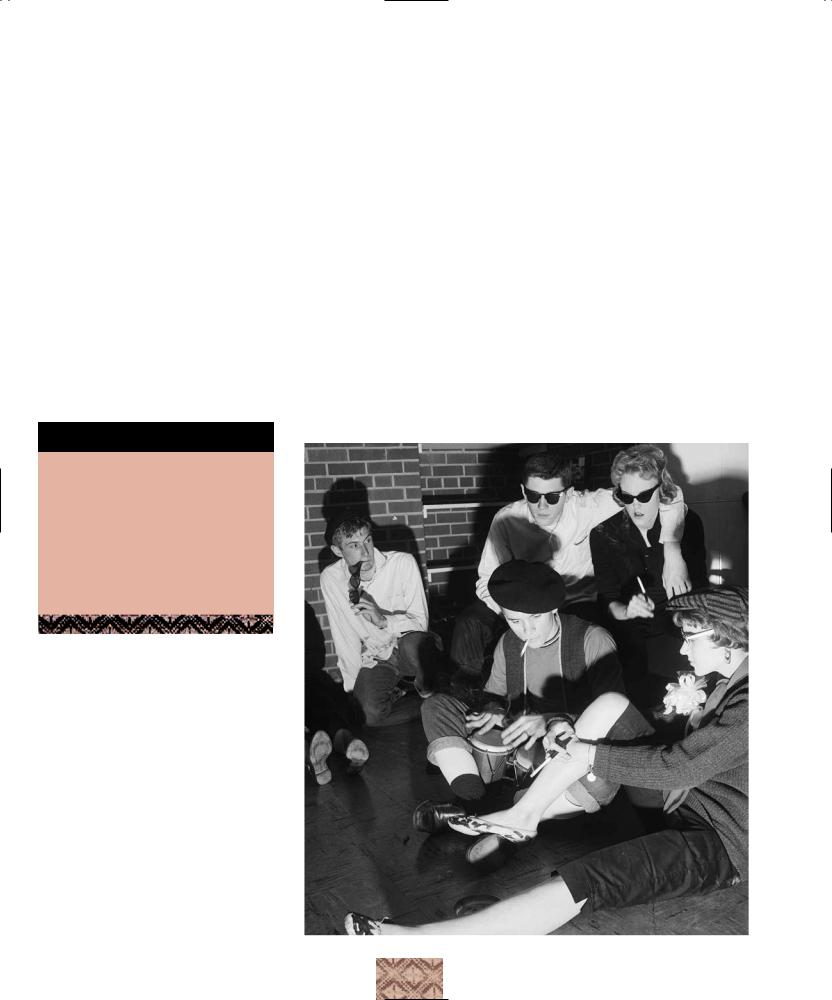
E N D L E S S B L A C K
“ The beat look is the news at Dior
. . . pale zombie faces; leather suits and coats; knitted caps and high turtleneck collars, black endlessly.”
Vogue magazine, 1960
Right: For 1950s beatniks, berets and dark glasses were vital accessories. At the time, smoking was seen as a “cool” activity. Re-enactors today can use dummy cigarettes to capture the look.
The greaser look is easy to achieve. The jeans must be narrow, with the bottom of the leg rolled up, and they should be worn with boots, a white T-shirt (perhaps under a shirt left open at the neck), and a black leather biker jacket.
B E A T N I K S A N D B U M S
The anarchic beat culture that emerged in the late 1950s was rebellious and radical, inspired by jazz music and rejecting American materialism and capitalist politics. Beatniks had a distinctive look characterized by close-fitting black turtleneck sweaters or T-shirts, worn with jeans. They also wore oversized chunky knit sweaters in plain, dark colors.
Distinctive details were a small goatee beard, open-toed leather sandals, a beret, and sunglasses. Men and women in the beat movement often dressed entirely in black. Women’s beatnik fashions included black leotards and wearing their hair long, straight and unadorned in a rebellion against the middle-class culture of beauty salons.
26
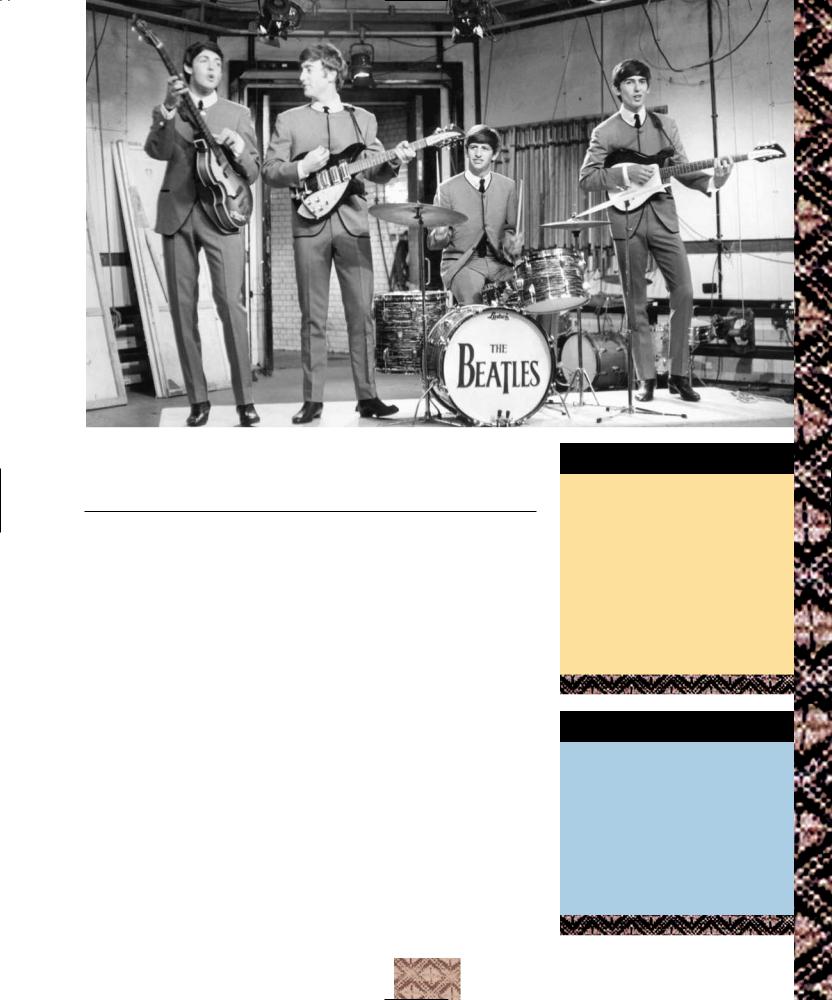
Above: The Beatles—Paul McCartney, John Lennon, Ringo Starr and George Harrison (left to right)—seen here wearing their trademark collarless suits by designer Pierre Cardin.
T H E L O N D O N L O O K
In the 1960s, London became the center of the fashion world. The term “Swinging London” was coined to describe the dynamic changes of the time and the city that appeared to be at the heart of this revolution. The fashion designer, Mary Quant, and the model Twiggy, with her tiny frame, mod-cropped hair and miniskirts, came to symbolize the youth movement that was associated with Swinging London. The British Union Jack flag became a fashion feature on coats, dresses, hats and bags.
The Beatles, a Liverpudlian pop group who rose to fame in 1962–63, were closely associated with the London look. The four band members wore impeccable dark suits with boxy jackets and narrow lapels. Under the jacket, they wore a white shirt with a small collar and narrow tie. Later, they wore suits designed for them by Pierre Cardin, which had distinctive collarless jackets with rounded necks. Their pants were narrow drainpipes, often worn over short boots. The Beatle look was an adaptation of the mod look, and it was widely copied all around the world. Men soon wore dark, close-fitting sweaters with their drainpipes. They were dapper and stylish, with a clean, slim outline.
S T Y L E T I P
No 1960s re-enactment would be complete without hot pants. These “short shorts” are very tight and spectacularly brief, with a maximum inseam length of 2 inches (about
6 centimeters). Long legs are an asset to hot pants wearers, as are dark, heavy-denier pantyhose!
U N I S E X C L O T H E S
Some looks, such as flared pants and frilly shirts, were “unisex,” worn by both men and women. Shops selling unisex clothes opened first in the fashionable areas of London around Carnaby Street, Camden Town, and Chelsea.
27
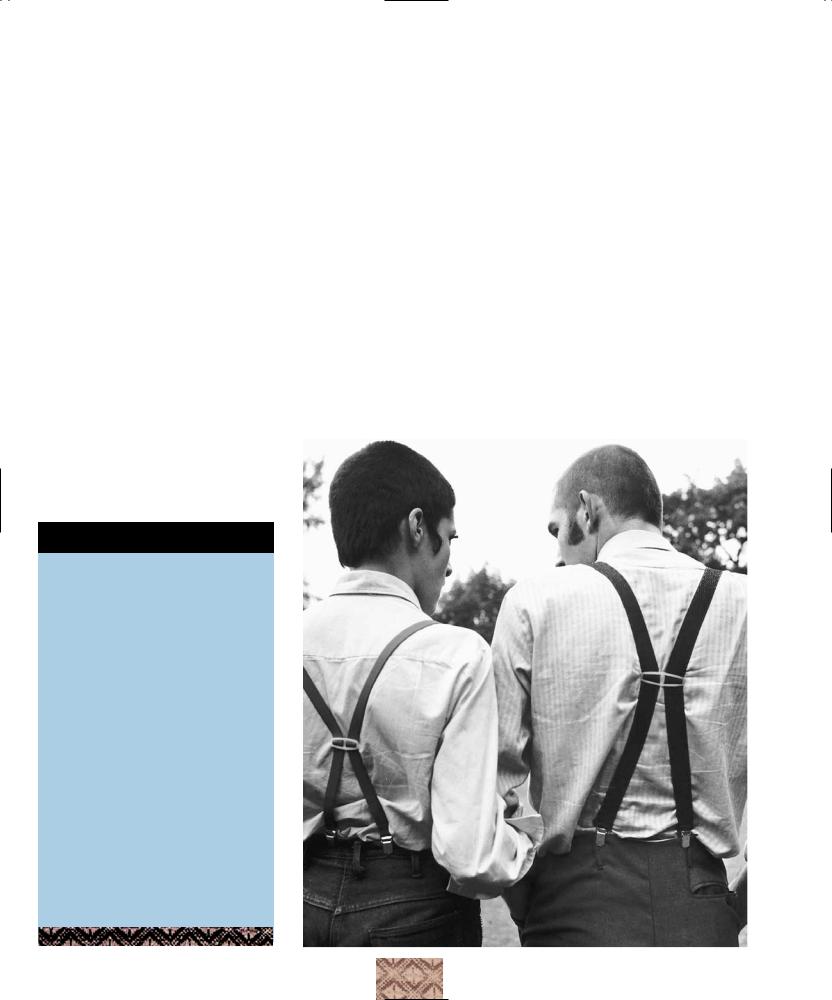
Right: Skinheads adopted an
aggressive look with very short
haircuts and suspenders.
D R . M A R T E N S
When the German doctor Klaus Maertens developed a modified army boot with an air-cushioned sole to support an injured ankle, he hit on a style that would become an important fashion accessory. In 1960, he added yellow stitching to the red leather boot, anglicized the name to Dr. Martens, and released his design onto the UK market. It was an instant success. DMs, as they soon became known, later appeared in a range of colors and in a 14-hole style as well as the original eight hole. They were central to the skinhead look.
M O D S A N D R O C K E R S
In Britain in the early 1960s, two rival teen cultures, mods and rockers, were in conflict. The rockers were similar to the American greasers. They rode motorcycles, wore leather jackets, and cultivated a hard, masculine image. Items of rocker clothing, such as black leather biker jackets, are still current. The mods rode scooters, wore clean-cut designer suits, and adopted an air of sophistication. Mods protected their suits with a trademark coat, the parka. This was a long, baggy, padded jacket with a fur-trimmed hood, an army surplus item that was cheap and practical.
S K I N H E A D S
The most hard-line followers of the mod movement took the style a step further: these “skinheads” looked scary and at times displayed aggressive behavior. They wore jeans, Fred Perry sportswear, and a Ben Sherman shirt with a button-down collar. They included details such as inch-wide suspenders, Dr. Martens lace-up boots, sweater vests, and cardigans. True to their name, skinheads cropped their hair very short.
28
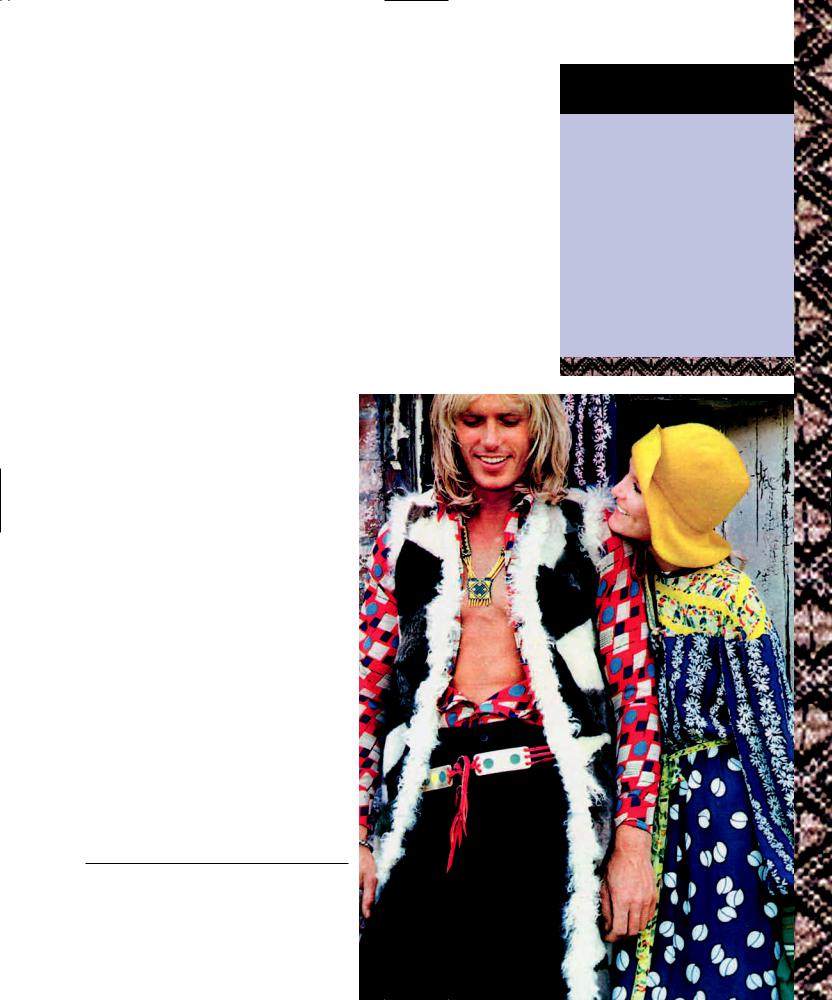
Skinheads wore their jeans turned back several inches into deep cuffs to show off their boots. The jeans were often bleached, which skinheads achieved by just spilling bleach on them. This is easy to copy, but remember to wash the bleach off when the color fades and before the fabric disintegrates! (Always remember to wear rubber gloves and handle bleach with care; it can cause serious skin burns.) A thick tartan or check shirt over a white T-shirt and Dr. Martens boots will complete the look.
H I P P I E S
In the late 1960s, the “peace and love” ethos of the hippie movement emerged as a counterbalance to the aggressive stance of the skinheads. Men’s hippie clothing, like that of women, took its inspiration from ethnic garments around the world. Kaftans—long loose robes with wide sleeves—were borrowed from Morocco. Shirts were often wide and loose, with voluminous sleeves and no cuffs or collar. They were decorated with embroidery or beads. T-shirts remained
popular, often with batik or tie-dyed patterns or printed with logos, slogans, and artistic designs. Men went barefoot or wore open-toed leather sandals.
Hippies wore their hair long and were comfortable wearing beads and other jewelry, especially if it had an ethnic flavor. Coats and loose vests were long and made of ornate fabrics such as brocade and velvet or were knitted or crocheted from yarn. Particularly popular at the end of the 1960s and into the 1970s was the huge, shaggy Afghan coat. This was made from sheepskin, with the fur on the inside but showing prominently at the hem, cuffs, neck, and front opening. It was often decorated with embroidery around the cuffs, hem, and front opening.
Make flared pants by slitting the leg seam of a pair of pants such as jeans from the ankle to the knee and stitching in a
Right: The hippie look allowed men to wear effeminate-looking clothes and have long hair, challenging conventional ideas about gender roles.
M A K E I T — A H I P P I E V E S T
Cut three rectangles of fabric, one for the back and two narrower ones for the front panels. They should be long enough to reach from shoulder to mid-thigh. Shape armholes and the front opening, then stitch the front panels to the back at the shoulders and under the arms. The use of felt as a fabric avoids the need to hem the edges.
